Task managers have become an integral part of team work. According to data from Cloudwards, small businesses spend an average of $8.9 per user per month on such services, while the average spend is about $16.88. In reality, the numbers are even higher: companies often overpay for more expensive plans for a single necessary feature or use several different platforms — for tasks, reporting, file sharing, and messaging.
Worksection offers a different approach. Here, all the key tools for project management are available right away at an affordable price — starting from $3.4 per user. Kanban, Gantt charts, reporting, time tracking, and communication within tasks — this is part of every plan.
In this article, we will discuss the hidden costs that arise when working with popular task managers and why Worksection is a beneficial alternative for teams of any size.
Why companies overpay for task managers
 Rising costs as the team grows
Rising costs as the team grows
Many services seem affordable while the team is small. But as soon as you start to scale, the cost increases sharply. For example, a $10 per user plan becomes $200 monthly for a team of 20 people — and this is just the basic payment without additional features.
 The necessity to purchase more expensive plans for a single feature
The necessity to purchase more expensive plans for a single feature
In many services, key tools like Gantt charts, time tracking, or advanced reports are only available in premium packages. Teams are forced to overpay several times for one necessary option, getting dozens of “unnecessary” features that they do not even use.
 Additional plugins for basic functions
Additional plugins for basic functions
Some services offer basic features only through separate modules or integrations: from access restrictions and email notifications to reports or even simple time tracking. This not only increases costs but also creates chaos in operations — one has to search for, connect, and pay for third-party solutions.
 Limitations of free versions
Limitations of free versions
Free plans usually have serious limits: on the number of users, integrations, or the volume of stored files. This may fit a startup with a few people, but as soon as the team grows, one has to look for different software or switch to expensive plans.
How Worksection addresses these challenges
In Worksection, you get the full set of necessary tools at once — without additional plugins or costly plans. This allows teams of any size to effectively manage tasks and communication at a transparent price.
Affordable price and transparent pricing policy
In Worksection, there are no hidden charges: even in basic plans, you get a full suite of tools for task management, communication, and reporting — from Gantt charts to time tracking. Prices start at $3.4 per user per month — with no hidden limitations or need for upgrades.
What this means for the team:
- No need to purchase more expensive packages just for a single feature;
- Costs are predictable and clear;
- One system covers planning, reporting, and communication.
Full feature set without additional payments
 Interactive dashboards
Interactive dashboards
In Worksection, the main page of each project is a dashboard that provides access to all key metrics:
- task completion progress and deadline adherence;
- team workload and work distribution;
- financial metrics — budget usage, time spent, completed hours.
Dashboards are available to all project participants and help the team see the big picture, analyze key metrics, and make quick decisions. They can also be exported to PDF or PNG for presentations and reports.
The main advantage is that the dashboard in Worksection is interactive: you can switch between blocks, customize the appearance, and display data according to your tasks. This transforms the dashboard into a convenient real-time working tool rather than just static analytics. That’s why there’s no need for additional BI services or complex add-on modules.
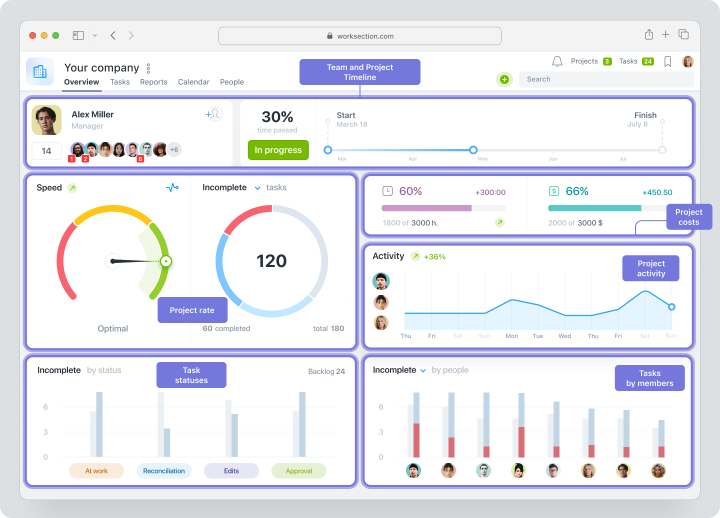
 Gantt Chart
Gantt Chart
The Gantt chart allows you to visualize all tasks on a shared timeline. This helps to see how different stages are interconnected, understand the team’s workload, and make quick informed management decisions. In a Gantt chart, you can:
- set deadlines and edit tasks directly from the timeline in real-time;
- specify dependencies between tasks;
- configure filters to display only the relevant information;
- export charts for reporting or presentations;
- switch between viewing a single project or all account activity.
In Worksection, the Gantt chart is included in all basic plans, so teams get a powerful planning tool without needing to upgrade to more expensive plans.
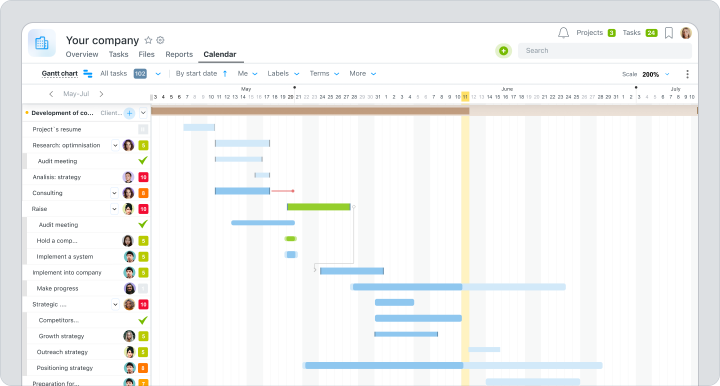
 Kanban
Kanban
Kanban — is a simple way to organize tasks by status. Tasks are displayed as cards that move between columns via Drag&Drop according to the workflow.The Worksection Kanban easily adapts to any type of project, the team’s working style, or workflows. This allows for quick monitoring of task statuses, understanding workload, and responding to changes in real-time.
Worksection Kanban capabilities:
- Project kanban — displays tasks within a single project.
- Project overview — a convenient account-level overview, useful for agencies and companies with multiple clients (available in Premium plans and above).
- People kanban — grouping tasks by responsible individuals for assessing workload.
- Daily kanban — calendar view of tasks with deadlines.
- Custom statuses and tags — adaptation to the team’s workflows.
- Process automation — rules for quickly assigning responsibilities or deadlines.
- Filters — search for tasks by assignees, tags, or deadlines.

 Time Tracking
Time Tracking
Time tracking in Worksection allows teams to accurately track the time spent on tasks directly in the system. Each participant can start a timer, log working hours, and link them to specific tasks, helping to analyze productivity and plan resources.
Main features and advantages:
- Built-in timer – log time without external apps.
- Plan vs fact comparison – assess the effectiveness of task execution.
- Reporting – generate detailed reports on time spent for analysis and planning.
- Transparency – the team sees how much time is spent on each task, enhancing openness and control.
This feature is also available in the Worksection basic plan, so users do not need to spend money on separate trackers or integrate third-party services.
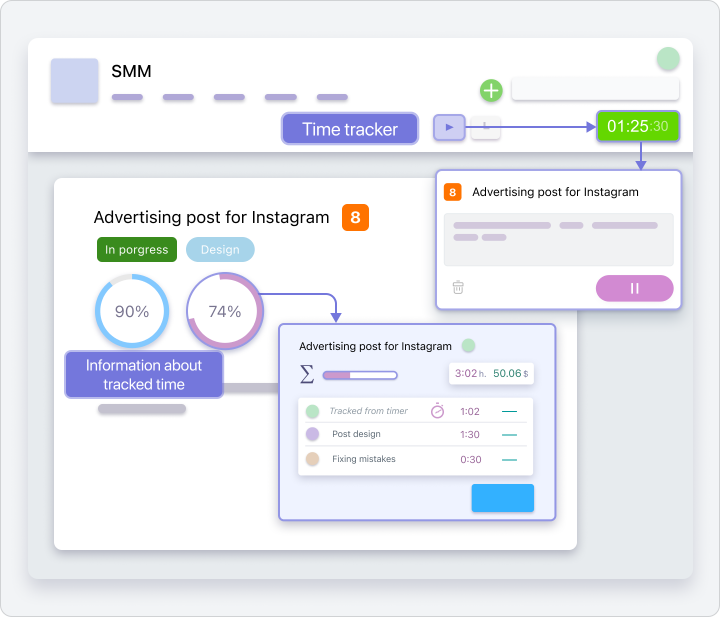
 Reports without Excel and unnecessary modules
Reports without Excel and unnecessary modules
In Worksection, reports are generated automatically based on key metrics: plan execution, participant progress, time spent, and financial indicators. This reduces routine reporting and allows focusing on strategic tasks.
Main tools:
- Automatic report generation – without the need for manual data collection.
- Template customization – for different roles: managers, teams, clients.
- Export to convenient formats – for further analysis or presentations.
- Personalization of notifications – receive only important information.
In the basic Worksection plan, you get a full set of reports and analytics without the need to purchase additional modules or integrations.
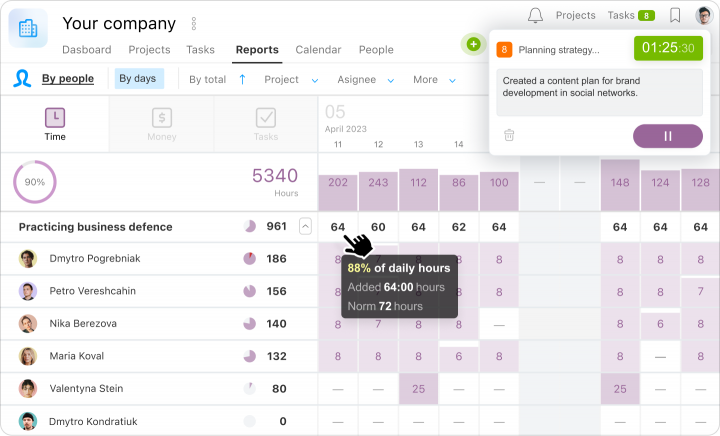
 Communication and files — in the context of tasks
Communication and files — in the context of tasks
In Worksection, all discussions and documents are stored directly within tasks. This allows the team not to waste time searching for necessary emails or messages in chats.
Main features and advantages:
- Task discussions — all comments are tied to a specific task, reducing confusion.
- Files and documents — upload and store files directly in tasks, without the need for separate sharing services.
- Communication history — all context of work is preserved, allowing new participants to quickly familiarize themselves with the project.
- Team transparency — everyone sees who is doing what, increasing trust and control.
Thus, there is no need for third-party messengers and numerous chats — and, accordingly, costs associated with them.
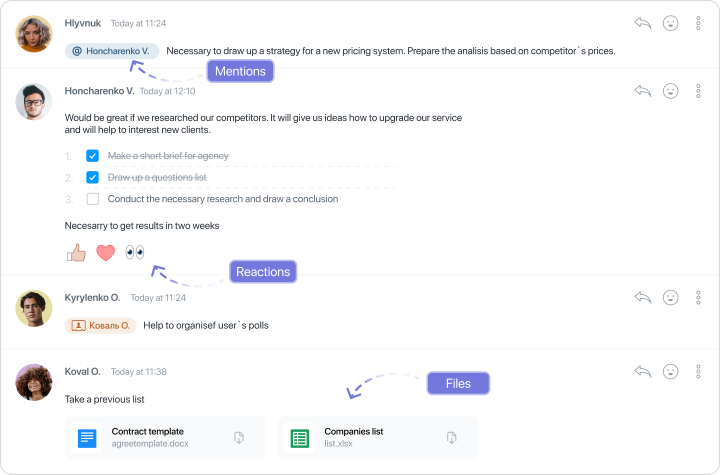
 Personalized notifications
Personalized notifications
Worksection has a notification system that allows all project participants to stay updated on events — changes in tasks, new comments, approaching or changing deadlines and statuses, assignments of responsibility, etc. Notifications can be customized individually for each user. You can choose which events are truly important, set priority levels, and delivery channels.
Notifications can be received:
- in the form of email letters;
- as push notifications in the browser or mobile app;
- through integration with messengers (via API).
This helps the team not to miss important updates and makes work more convenient — without additional services and setups.
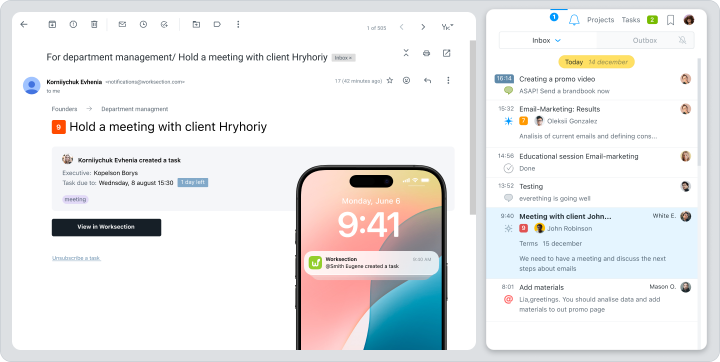
 A single platform for work
A single platform for work
Worksection combines tasks, communication, files, and reports in a single environment. The team no longer needs to switch between multiple services — everything needed for project management is immediately available.
This provides teams with:
- Centralization of processes — tasks, comments, files, and analytics in one interface.
- Reduction of chaos — the team works with one platform instead of 3 – 4 different services.
- Simple onboarding of newcomers — new employees quickly adapt, as they need to learn only one tool.
- Time and budget savings — one service instead of several subscriptions and plugins.
Worksection allows the team to focus on work, not on switching between different tools.
 Integrations and easy migration from other services
Integrations and easy migration from other services
Worksection combines all the necessary services in one environment. You can connect Google Drive, Telegram, Slack, Email, and other popular services, as well as import data from other systems.
Worksection supports integrations with:
- Calendars (Google Calendar, Outlook) — to see deadlines in personal schedules;
- Email clients — to create tasks directly from emails;
- CRM systems — to synchronize with sales processes;
- Messengers — to receive important updates also in Slack, Telegram, and others.
- all projects and tasks with subtasks;
- deadlines and assignees;
- comments and discussions;
- attached files — they will stay within the corresponding tasks and organized by projects.

Thanks to integrations and easy migration, Worksection allows teams to quickly set up work in a unified environment and replace several separate services, saving time and budget.
How Worksection saves the team’s time and resources
- Less chaos — more focus
Instead of 3 – 4 different platforms, the team works in a single system. This reduces the number of errors, task duplication, and confusion.
- Quicker decision making
All discussions, files, and deadlines are tied to tasks. The team doesn’t have to waste time searching for necessary emails or messages in chat — decisions are made faster and more confidently.
- Complete project overview
Dashboards and reports show the team’s workload, progress, and bottlenecks. This allows managers to respond to problems in a timely manner and avoid missed deadlines.
- Budget savings
One subscription replaces several separate services: task manager, time tracker, reporting system, and internal communication. The team gets full functionality without unnecessary expenses.
- Quick onboarding of newcomers
New employees quickly adapt, as they only need to master one tool — Worksection.
Comparison of Worksection features with Asana, Monday.com, and Trello
| Parameter | Worksection | Asana | Monday.com | Trello |
| Price* | From $3.4 | From $10.99 | From $8 | From $5 |
| Kanban |  |  |  |  |
| Gantt Chart |  |  In the Premium plan In the Premium plan |  |  Integration required Integration required |
| Time Tracking |  |  In the Premium plan In the Premium plan |  In the Premium plan In the Premium plan |  Integration required Integration required |
| Reports |  |  In the Premium plan In the Premium plan |  |  Limited Limited |
| Integrations |  |  |  |  |
| User Ratings | 4.8 / 5 on G2 4.9 / 5 on Capterra | 4.5 / 5 on G2 4.3 / 5 on Capterra | 4.7 / 5 on G2 4.6 / 5 on Capterra | 4.4 / 5 on G2 4.5 / 5 on Capterra |
*price is listed per user/month
Worksection boasts the lowest price among competitors while maintaining a full functionality for project management and team collaboration.
Asana and Monday.com offer extended capabilities but at a higher price, which is not always justified for small and medium teams.
Trello is a good tool for simple projects, but for more complex tasks, you will need additional integrations and settings.
Conclusions
As a team grows, project management becomes more complicated, and software costs increase. Many services require additional subscriptions, and to function effectively, one often has to use multiple platforms simultaneously. This not only adds expenses but also creates chaos and takes time.
In Worksection, all the key tools for task management, time tracking, communication, and reporting are gathered in one service. The platform remains accessible for any teams — from $3.4 per user per month.
With Worksection, you get the maximum features for the minimum cost. Try Worksection free for 14 days and see for yourself how easy it is to manage projects in one service.